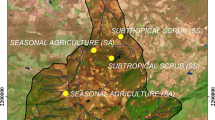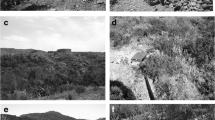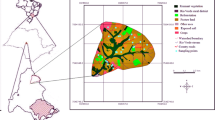Abstract
The effect of northeast monsoon rainfall to soil erosion on hillslope adjacent the Guthrie Corridor Expressway, Malaysia, is investigated by examining a relationship between vegetation covers and slope steepness. Five plot-scale study areas [i.e., NBNM, PDM, PDNM, NBM and natural dense microbe (NDM)] are marked on the hillslope with different percentage and type of vegetation densities. Experimental equipment is set up at those plots to collect rainwater and soil loss starting from November 2014 until March 2015 with twice collection per month. Based on the data collected, the effect of different vegetation densities associated to soil loss is examined. These are the conclusions that can be made based on this investigation: (1) the observed rainfall pattern shows that mostly the recorded rainfall depth is about 5 mm with 20 min duration of rainfall; (2) plot without vegetation cover (i.e., NBNM) yields greater soil loss with the maximum runoff, whereas the least is exhibited by the plot having NDM. Meanwhile, the rate of soil loss is found greater for the planted vegetation compared to the natural plant; (3) a positive relationship is found between runoff and slope steepness regardless of the vegetation cover types.








Similar content being viewed by others
References
Adham M, Shirazi S, Othman F, Rahman S, Yusop Z, Ismail Z (2014) Runoff potentiality of a watershed through SCS and functional data analysis technique. Sci World J. https://doi.org/10.1155/2014/379763
Akrami SA, Nourani V, Hakim S (2014) Development of nonlinear model based on wavelet-ANFIS for rainfall forecasting at Klang Gates Dam. Water Resour Res 28(10):2999–3018
Azamathulla HM, Ghani AA (2010) ANFIS-based approach for predicting the scour depth at culvert outlets. Water Resour Res 2(1):35–40
Boix-Fayos C, Martínez-Mena M, de Vente J, Albaladejo J (2009) Influence of land use changes on soil carbon stock and soil carbon erosion in a Mediterranean catchment. Paper presented at the Congreso Internacional sobre Desertificación
Caraman S, Sbarciog M, Barbu M (2007) Predictive control of a wastewater treatment process. Int J Comput Commun Control 2(2):132–142
Chang FJ, Chang LC, Wang YC (2014) Artificial intelligent techniques for optimizing water allocation in a reservoir watershed. Paper presented at the EGU General Assembly Conference Abstracts
Dastorani MT, Moghadamnia A, Piri J, Rico-Ramirez M (2010) Application of ANN and ANFIS models for reconstructing missing flow data. Environ Monit Assess 166(1–4):421–434
Dunne T (1977) Evaluation of erosion conditions and trends. In: Kunkle SH, Thames JL (eds) Guidelines for watershed management. FAO conservation guide 1, UN Food and Agriculture Organization, Rome, pp 53–83
Firat M, Güngör M (2007) River flow estimation using adaptive neuro fuzzy inference system. Math Comput Simul 75(3):87–96
Gautam D, Holz K-P (2001) Rainfall-runoff modelling using adaptive neuro-fuzzy systems. J Hydroinf 3(1):3–10
Gernaey KV, van Loosdrecht MC, Henze M, Lind M, Jørgensen SB (2004) Activated sludge wastewater treatment plant modelling and simulation: state of the art. Environ Model Softw 19(9):763–783
Goodwin GC, Sin KS (2014) Adaptive filtering prediction and control. Courier Corporation, North Chelmsford
Greacen EL, Sands R (1980) Compaction of forest soils. A review. Soil Research 18(2):163–189
Hamilton SK, Hussain MZ, Lowrie C, Basso B, Robertson GP (2017) Evapotranspiration is resilient in the face of land cover and climate change in a humid temperate catchment. Hydrol Process 32(5):655–663
Islam MR, Jaafar WZW, Hin LS, Osman N, Hossain A, Mohd NS (2018) Development of an intelligent system based on ANFIS model for predicting soil erosion. Environ Earth Sci 77(5):186
Khaki M, Yusoff I, Islami N (2015) Simulation of groundwater level through artificial intelligence system. Environ Earth Sci 73(12):8357–8367
Kim S, Shiri J, Kisi O, Singh VP (2013) Estimating daily pan evaporation using different data-driven methods and lag-time patterns. Water Resour Manag 27(7):2267–2286
Kumar P, Kumar D, Jaipaul A (2012) Evaporation estimation using artificial neural networks and adaptive neuro-fuzzy inference system techniques. Pak J Meteorol 8(16):81–88
Lai SH, Soom M, Amin M, Law PL, Mah DYS (2008) Applications of GIS and remote sensing in the hydrological study of the Upper Bernam River Basin, Malaysia. J Inst Eng, Malays 69(1):13–18
Maerker M, Sommer C, Zakerinejad R, Cama E (2017) An integrated assessment of soil erosion dynamics with special emphasis on gully erosion: case studies from South Africa and Iran. Paper presented at the EGU General Assembly Conference Abstracts
Maier HR, Morgan N, Chow CW (2004) Use of artificial neural networks for predicting optimal alum doses and treated water quality parameters. Environ Model Softw 19(5):485–494
Martínez-Casasnovas JA, Ramos MC, Benites G (2000s) Soil and water assessment tool soil loss simulation at the sub-basin scale in the alt Penedès–Anoia Vineyard Region (Ne Spain) in the 2000s. Land Degrad Dev 27(2):160–170
Othman F, Muhammad S, Azahar S, Alaa Eldin M, Mahazar A, Othman M (2015) Impairment of the water quality status in a tropical urban river. Desalin Water Treat (ahead-of-print). https://doi.org/10.1080/19443994.2015.1012331
Ozsoy G, Aksoy E, Dirim MS, Tumsavas Z (2012) Determination of soil erosion risk in the Mustafakemalpasa River Basin, Turkey, using the revised universal soil loss equation, geographic information system, and remote sensing. Environ Manag 50(4):679–694
Panagos P, Borrelli P, Meusburger K, Alewell C, Lugato E, Montanarella L (2015) Estimating the soil erosion cover-management factor at the European scale. Land Policy 48:38–50
Piacentini T, Galli A, Marsala V, Miccadei E (2018) Analysis of soil erosion induced by heavy rainfall: a case study from the NE Abruzzo Hills Area in Central Italy. Water 10(10):1314
Rezaeianzadeh M, Tabari H, Yazdi AA, Isik S, Kalin L (2014) Flood flow forecasting using ANN, ANFIS and regression models. Neural Comput Appl 25(1):25–37
Shih S (1982) Rainfall variation analysis and optimization of gaging systems. Water Resour Res 18(4):1269–1277. https://doi.org/10.1029/WR018i004p01269
Talei A, Chua LHC, Wong TS (2010) Evaluation of rainfall and discharge inputs used by adaptive network-based fuzzy inference systems (ANFIS) in rainfall–runoff modeling. J Hydrol 391(3):248–262
Van der Helm A, Rietveld L (2002) Modelling of drinking water treatment processes within the Stimela environment. Water Sci Technol Water Supply 2(1):87–93
Vietz GJ, Lintern A, Webb JA, Straccione D (2017) River bank erosion and the influence of environmental flow management. Environ Manag 61(3):454–468
Wang J, Sun G, Shi F, Lu T, Wang Q, Wu Y, Oli K (2014) Runoff and soil loss in a typical subtropical evergreen forest stricken by the Wenchuan earthquake: their relationships with rainfall, slope inclination, and vegetation cover. J Soil Water Conserv 69(1):65–74. https://doi.org/10.2489/jswc.69.1.65
Wilson GV, Wells R, Kuhnle R, Fox G, Nieber J (2018) Sediment detachment and transport processes associated with internal erosion of soil pipes. Earth Surf Process Landforms 43(1):45–63
Yu RF, Kang SF, Liaw SL, Chen MC (2000) Application of artificial neural network to control the coagulant dosing in water treatment plant. Water Sci Technol 42(3–4):403–408
Zeng G, Qin X, He L, Huang G, Liu H, Lin Y (2003) A neural network predictive control system for paper mill wastewater treatment. Eng Appl Artif Intell 16(2):121–129
Zhang Q, Stanley SJ (1999) Real-time water treatment process control with artificial neural networks. J Environ Eng 125(2):153–160
Zhang GH, Liu GB, Wang GL, Wang YX (2011) Effects of vegetation cover and rainfall intensity on sediment-associated nitrogen and phosphorus losses and particle size composition on the Loess Plateau. J Soil Water Conserv 66(3):192–200. https://doi.org/10.2489/jswc.66.3.192
Zhang QG, Huang RQ, Liu Y-X, Su X-P, Li G-Q, Nie W (2016) A physically based geometry model for transport distance estimation of rainfall-eroded soil sediment. Appl Sci 6(2):34
Zhang X, Lin P, Chen H, Yan R, Zhang J, Yu Y, Lv D (2018) Understanding land use and cover change impacts on runoff and sediment load at flood events on the Loess Plateau, China. Hydrol Process. https://doi.org/10.1002/hyp.11444
Acknowledgements
The authors would like to acknowledge the University of Malaya for overall financial support and the PROLINTAS Expressway Sdn. Bhd., Malaysia, for using their Guthrie Corridor Expressway (GCE) slopes as experimental sites. This research was carried out by University of Malaya Research Grant (UMRG) under the project “Investigate Soil Hydrological Aspects and Vegetation Cover for Slope Erosion” Project No. PR005B-13SUS.
Author information
Authors and Affiliations
Corresponding author
Additional information
Publisher's Note
Springer Nature remains neutral with regard to jurisdictional claims in published maps and institutional affiliations.
Rights and permissions
About this article
Cite this article
Jaafar, W.Z.W., Islam, M., Hin, L.S. et al. Assessment of rainfall-induced soil erosion on hillslope: a case study at the Guthrie Corridor Expressway, Malaysia. Sustain. Water Resour. Manag. 6, 25 (2020). https://doi.org/10.1007/s40899-020-00385-9
Received:
Accepted:
Published:
DOI: https://doi.org/10.1007/s40899-020-00385-9




